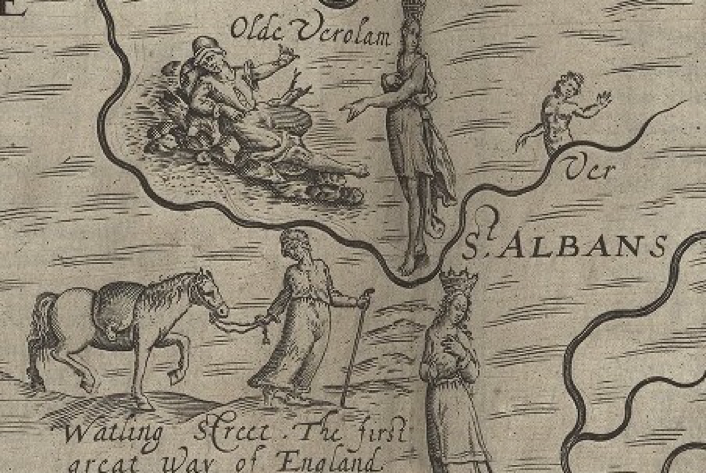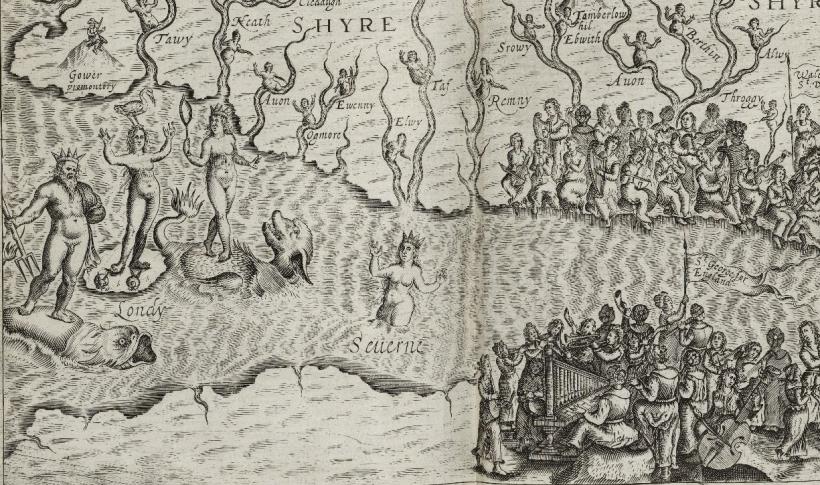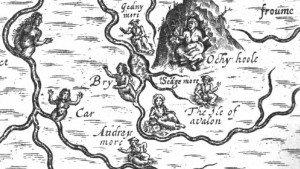In Poly-Olbion’s Sixteenth Song, the River Ver and the Roman road known as Watling Street recall how much better things were in the old days: “we have liv’d to see / Things in farre better state then at this time they be.” The Ver, once a mighty flood, is now a paltry brook; the soil in this part of Hertfordshire, once renowned for its fruitfulness, now “scarce repayes the seed first cast into the Land.” Such nostalgic laments are common enough in Poly-Olbion, but when Watling asks to know the reasons behind this environmental collapse, Ver offers a rather surprising explanation.
Behold that goodly Fane, which ruind now doth stand,
To holy Albon built, first Martyr of the Land;
Who in the faith of Christ from Rome to Britanne came,
And dying in this place, resign’d his glorious Name.
In memory of whom, (as more then halfe Divine)
Our English Offa rear’d a rich and sumptuous shrine
And Monastary heere: which our succeding kings,
From time to time endow’d with many goodly things.
And many a Christian Knight was buried heere, before
The Norman set his foote upon this conquered shore;
….
Which now devowring Time, in his so mighty waste,
Demolishing those walls, hath utterly defac’t.
So that the earth to feele the ruinous heaps of stones,
That with the burth’nous weight now presse their sacred boanes,
Forbids this wicked brood, should by her fruits be fed;
As loathing her owne womb, that such loose children bred.
Ver thus traces the impoverishment of the local soil to the downfall of St Albans Abbey. Behind the figure of “devowring Time” lurks the nemesis of the monasteries, Henry VIII.
When Drayton wrote, the Abbey Church of St Albans was indeed in a pitiful condition. Once the premier Benedictine monastery of England, it had been reduced after the Reformation to the status of a parish church. (St Albans did not become a cathedral until 1877.) Although not entirely “ruind,” the walls and roof of the church were in a poor state of repair, and its final demolition seemed a likely prospect. Yet in 1612, the year of Poly-Olbion’s publication, fortune smiled on St Albans in the form of a visit by James I. The king authorized a collection for the repair of the church, and over the next decade much necessary work was done to shore up and renovate the building.
Between 1612 and 1623, as the work of repair advanced, a number of poems were painted on the walls and pillars of St Albans, memorializing some of the lost glories of the church. The authors of these verses are unknown, and their texts mostly survive only as recorded by seventeenth-century antiquaries. On his visit to the church in 1617-18, John Weever recorded a poem on the wall beside the site of Alban’s vanished shrine. For those interested in the early reception and reputation of Drayton’s poem, the verses are of great interest.
Renowned Alban knight, first Martyr of this land,
By Dioclesian lost his life through bloudy hand,
Who made him soveraigne Lord, high Steward of this Isle,
And Prince of Britaine knights to dignifie his stile,
He veritie embrac’t, and Verulam forsooke,
And in this very place his martyrdome he tooke.
Now hath he his reward, he lives with Christ above,
Fore he above all things, Christ and his truth did love.
Here Offa, Mercians King, did Albans bones enshrine
So all things were dispos’d by providence divine.
Nought but this marble stone, of Alban’s shrine is left
The worke of all forme else, hath changing time bereft.
Someone at St Albans had been reading Poly-Olbion. Not only are the verses in Drayton’s alexandrine couplets (a relatively rare form in the period), but there are a number of close verbal echoes. (“To holy Albon built, first Martyr of the Land”/ “Renowned Alban knight, first Martyr of this land”; “Our English Offa rear’d a rich and sumptuous shrine”/ “Here Offa, Mercians King, did Albans bones enshrine”.) Like Ver in Poly-Olbion, the St Albans poem lays the blame for the shrine’s downfall at the feet of “time.” (It does not go on, as Ver does, to castigate the “wicked brood” of “loose children” who share responsibility with Time for the Abbey’s fate.)
Who wrote the poems on the walls of St Albans? It is tempting to wonder if, in this case at least, it might have been Drayton himself. Yet this is not very likely. Although the verses closely imitate Poly-Olbion in manner as well as matter, they are not quite in Drayton’s style. The St Albans poet works consistently in half-lines broken by strong caesuras, and makes very little use of enjambment. The verses plod steadily forward, rather than flowing as Drayton’s often do. A line such as “And many a Christian Knight was buried heere, before/ The Norman set his foote upon this conquered shore” is beyond the reach of this poet.
The strong likelihood is that this text is the work of someone associated with St Albans, possibly a clergyman, who read Poly-Olbion in its 1612/13 edition and saw the possibility of adapting Ver’s lament for a local purpose. As well as ranking among the earliest poetic responses to Poly-Olbion, the poem may offer an insight into the practice of Drayton’s early readers, who would likewise have focused on the passages dealing with their own localities. How many others, who did not necessarily paint their verses on the walls of medieval buildings, also tried their hands at imitating Drayton’s style?
Ver’s lament circles back, ultimately, to the landscape and the theme of environmental degradation. The St Albans poem does not do so, but maintains its focus throughout on the saint and his lost shrine. In context this is not surprising, but it serves as a reminder of Poly-Olbion’s capaciousness and flexibility. Drayton’s poem is about architecture as well as landscape, shrines as well as soils. For at least one reader in the early seventeenth century, he was admirable as a historian of the English church.
Philip Schwyzer




